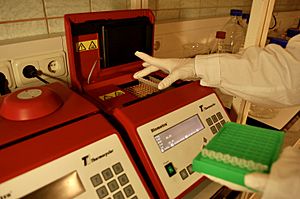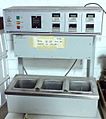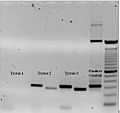Polymerase chain reaction facts for kids
Polymerase chain reaction (PCR) is a clever way to make many, many copies of a specific part of DNA. Think of it like a special copy machine for DNA! This process happens in a lab using a special helper molecule called an enzyme, specifically DNA polymerase. It's called a "chain reaction" because each new copy made is then used to make even more copies, causing the amount of DNA to grow super fast, like an exponential explosion!
PCR is super useful in many areas of biology and biochemistry. Every living thing has its own unique DNA. Sometimes, scientists can only get a very small amount of DNA from a sample, which isn't enough to study properly. That's where PCR comes in! It helps scientists make enough copies of that tiny DNA sample to do important experiments. Because of this, PCR is one of the most common tools used in genetics labs worldwide. It helps with things like understanding diseases, developing new treatments, and even solving mysteries in forensics.
This amazing process was first developed in 1983 by a scientist named Kary Mullis. While others had thought about similar ideas, Mullis was the first to make PCR actually work in a practical way. For his important work on PCR, he was awarded the Nobel Prize in Chemistry along with Michael Smith.
Contents
How PCR Works
The PCR method involves a cycle of heating and cooling. This cycle causes the original DNA, which is called a "template," to separate and then be copied. Two key things are needed for this process: short pieces of DNA called "primers" and the DNA polymerase enzyme. The primers are like tiny guides that stick to the ends of the DNA part you want to copy.
The whole process happens in three main steps that repeat over and over:
Step 1: Denaturation
First, the DNA strands need to be separated. DNA normally exists as two strands twisted together, held by weak connections called hydrogen bonds. To separate them, the sample is heated to a high temperature. This heat breaks those connections, causing the two DNA strands to "melt" apart.
Step 2: Annealing
Next, the sample is cooled down. This cooling allows the short DNA pieces, called primers, to attach, or "anneal," to the correct spots at the ends of each of the two separated DNA strands. The primers are designed to stick only to the specific DNA sequence that scientists want to copy.
Step 3: Extension
Finally, the temperature is raised slightly. This is the perfect temperature for the DNA polymerase enzyme to get to work. The enzyme attaches to the primers and starts building a new, matching DNA strand for each of the separated template strands. It basically "extends" the primer by adding the correct DNA building blocks.
After just one cycle, you'll have 4 DNA strands instead of the original 2. When the process repeats with these 4 strands, they will make 8 strands. Then, those 8 strands will make 16, and so on! This means that PCR doubles the amount of DNA in a sample after each cycle. Because of this rapid doubling, it's possible to get millions of copies of a specific DNA piece in just a few hours.
Images for kids
-
Ethidium bromide-stained PCR products after gel electrophoresis. Two sets of primers were used to amplify a target sequence from three different tissue samples. No amplification is present in sample #1; DNA bands in sample #2 and #3 indicate successful amplification of the target sequence. The gel also shows a positive control, and a DNA ladder containing DNA fragments of defined length for sizing the bands in the experimental PCRs.
See also
 In Spanish: Reacción en cadena de la polimerasa para niños
In Spanish: Reacción en cadena de la polimerasa para niños









